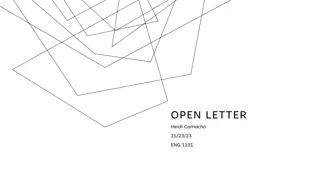
Advanced Joint Modelling and Design Analysis with CBFEM
Explore advanced concepts in joint modelling, CBFEM principles, and online training for engineers. Understand the difference between numerical simulation and calculation. Learn about validation, verification, and benchmark cases.
Download Presentation

Please find below an Image/Link to download the presentation.
The content on the website is provided AS IS for your information and personal use only. It may not be sold, licensed, or shared on other websites without obtaining consent from the author. If you encounter any issues during the download, it is possible that the publisher has removed the file from their server.
You are allowed to download the files provided on this website for personal or commercial use, subject to the condition that they are used lawfully. All files are the property of their respective owners.
The content on the website is provided AS IS for your information and personal use only. It may not be sold, licensed, or shared on other websites without obtaining consent from the author.
E N D
Presentation Transcript
Introduction C Connection onnection design by Component by Component Based design Based F Finite Design models inite E Element lement M Method ethod Global analyse Classification Component meth. Interaction Assessment I CBFEM General Validation Lecture Lecture 1 Beam to Beam to C Column 1 Verification olumn M Moment oment C Connection onnection Benchmark case Assessment II Summary
List of lectures 1) Beam to column moment connection 2) Hollow section joints 3) Joint of hollow to open section 4) Column base 5) Seismically qualified joints 6) Joints at elevated temperature Introduction Design models Global analyse Classification Component meth. Interaction Assessment I CBFEM General Validation Verification Benchmark case Assessment II Summary 2
Aims and objectives o Provide information on joint modelling of open section joints o Introduce principles of CBFEM Introduction Design models Global analyse o Provide an online training to students and engineers Classification Component meth. Interaction o Illustrate the differences between numerical simulation and numerical calculation, e.g., between research-oriented FEM and design-oriented FEM Assessment I CBFEM General Validation Verification Benchmark case o Show the process of Validation & Verification Assessment II Summary o Offer a list of references relevant to the topic 3
Lecture Lecture 1 1 Introduction Design models Global analyse B Beam eam to column moment connection to column moment connection Classification Component meth. Interaction Assessment I CBFEM General Validation Verification Franti ek Wald, Luk G drich, Marta Ku kov , Franti ek Wald, Luk G drich, Marta Ku kov , Abhishek Ghimire, Lubom r abatka, Jarom r Kabel , Lubom r abatka, Jarom r Kabel , Draho Abhishek Ghimire, Kojala Benchmark case Assessment II Draho Kojala Summary
Tutorial o This lecture describes principles of FEA modelling of beam to column moment connection. Introduction Design models o Survey of both simple and FEM analyses and modelling are shown. Global analyse Classification o Finally Validation, Verification and Benchmark case is presented. Component meth. Interaction Assessment I CBFEM General Validation Material was prepared under the R&D project MERLION II supported by Technology Agency of the Czech Republic, project No TH02020301. Verification Benchmark case Assessment II Summary 5
Outline of the lecture o Introduction to design o Design models o Global analyses o Classification o Component method o Interaction of internal forces o Assessment I o Component Based Finite Element Method o General o Validation o Verification o Benchmark case o Assessment II o Summary Introduction Design models Global analyse Classification Component meth. Interaction Assessment I CBFEM General Validation Verification Benchmark case Assessment II Summary 6
Introduction Introduction to design to design Introduction Design models Global analyse Classification Component meth. Interaction Assessment I Lecture Lecture 1 1 B Beam eam to column to column moment connection moment connection CBFEM General Validation Verification Benchmark case Assessment II Summary
8 Past and Present design models An example of component model for fire design (Block et al 2005) For joint design are available models: o Experimental - history and contemporary design o Curve fitting currently hollow section joints design o Analytical models o Component Method (CM) o Research oriented finite element method o Design oriented finite element method o Component based FE Method (CBFEM) Introduction Design models Global analyse Classification Component meth. Interaction Assessment I CBFEM General Validation M Experiment Verification Benchmark case Assessment II l Function M h t Summary b 1 3 5 = + + C ( kM ) C ( kM ) C ( kM ) 1 3 5 t a 8 An example of curve fitting model, Kishi and Chen (1990)
Joints characteristics in bending o Major characteristics for joint in bending are o Initial stiffness Sj,ini o Small influence to distribution of internal forces o Design resistance Mj,Rd o Direct influence to resistance o Deformation capacity Cd o Influence to plastic and seismic design only Introduction Design models Global analyse Classification Component meth. Interaction Assessment I CBFEM General Validation M Verification Mj,Rd Benchmark case Assessment II Summary S j,ini Cd 9
Design model and experimental behaviour o The design model reflects the need of designers to safe prediction of joint behaviour Introduction o As structural elements are in joint designed for its material yielding fy or its ultimate stress fu Design models Global analyse Classification o The experimentally reached resistance is never the asked design resistance Component meth. Interaction M, moment, kNm Assessment I Initial stiffness Sj,ini CBFEM Joint resistance Mj,Rd General Experimental curve Validation Verification Design curve Elastic limit Benchmark case Assessment II 2/3 Mj,Rd Summary Rotation, , mrad j,Cd Deformation capacity 10
Joints deformability/stiffness o Joint deforms due to o Shear force Introduction o No influence to global distribution of internal forces Design models o Is closed during erection o Normal force Global analyse Classification Component meth. Interaction o No influence to global distribution of internal forces Assessment I o Exception in space structures of course o Bending moment CBFEM General Validation Verification o Significant influence to distribution of internal forces Benchmark case o The highest is in rectangular closed frames Assessment II Summary 11
Joints in global analyses o Example of frame with its joints Introduction Design models Global analyse Classification Component meth. Interaction o If part of joint is flexible is in global analyses modelled as Assessment I CBFEM General Stiff Validation Flexible column web panel and semi-rigid connections Stiff column web panel and semi-rigid or pinned connections Stiff column web panel and semi-rigid or pinned connections column web panel and rigid connections Verification Benchmark case Assessment II Summary 12
Physical and theoretical joint o In global analyses with 1D members are forces transferred to beam ends. o Forces are kept and moments are modified by action of forces on actual arms. Introduction o Theoretical joint should be in equilibrium, see example right below. Design models Global analyse Classification Component meth. Interaction Assessment I F2 CBFEM General Validation Verification F1 Benchmark case F3 Assessment II Summary F1 + F2 + F3 = 0 13
Classification o For global analyses of steel frames are joints classified to simplify the modelling. (Preferable as pinned and rigid joints.) Introduction Design models Global analyse Classification o According to Ch. 5 in EN1993-1-8:2006 are joints classified based on Component meth. Interaction o Best engineering practice Assessment I CBFEM o Simplified assumption of frame behaviour General Validation o Actual influence of particular joint to frame design. (This implicates recalculation.) Verification Benchmark case Assessment II Summary 14
Classification based on resistance o Bending moment resistance of connection to bending moment resistance of connected beam is compared in connections loaded in bending. Introduction o Full strength joints/connections Mj,Rd > Mb,pl,Rd Design models Global analyse o Partial strength joints/connections Mj,Rd < Mb,pl,Rd Moment, Classification M Component meth. Interaction Assessment I Mb,pl,Rd Full strength connection CBFEM General Validation Partial strength connection Bending moment resistance of connected beam Verification Benchmark case Assessment II Summary Rotation, 15
Classification based on rotational capacity o Rotational capacity of connection to rotational capacity of connected beam is compared in connections loaded in bending. o Ductile connection o Semi-ductile connection o Brittle connection Moment, Introduction Design models Global analyse Classification Component meth. M Elastic rotation of connected beam Interaction M M Assessment I CBFEM Ultimate rotation of connected beam General Validation Verification (Class 1) Ductile connection Semi-ductile connection Benchmark case M (Class 2) (Class 3) Assessment II Summary Brittle connection Rotation, 16
Classification based on stiffness o Bending stiffness of connection to bending stiffness of connected beam is compared in connections loaded in bending. o Rigid joint Sj,ini 25 E Ib / Lb (for frames without bracing) o Semi-rigid joint Sj,ini,rigid Sj,ini Sj,ini,pinned o Nominally pinned joint Sj,ini 0,5 E Ib / Lb __ M b tuh sty n ky joints Introduction Design models Global analyse Classification Component meth. Pom rn moment, Relative moment Rigid __ M = M b M Interaction b Assessment I 1,0 b.pl.Rd CBFEM _ 0,8 I E General b = Sj.ini.n = 25 Validation L M b b.pl.Rd 0,6 Verification _ _ Sj.ini.s= 8 Benchmark case 0,4 S = 0,5 j.ini.p Assessment II polotuh sty n ky Semi-rigid joints 0,2 Summary Pinned joints kloubov sty n ky 0 0 0,1 0,2 0,3 Relative stiffness Pom rn tuhost, 17
Component Method o Component method is analytical procedure to evaluate joint resistance and stiffness. It consist of steps: 1) Decomposition of joint to individual components based on assumed distribution of internal forces. 2) Component description in terms of deformational stiffness and resistance. 3) Joint behaviour assembly from the behaviour of its components based on assumed distribution of internal forces. Column web in tension Introduction Design models Global analyse Classification Component meth. Interaction Assessment I CBFEM General Connection Validation Verification Benchmark case Components in tension Assessment II Summary Components in compression Web panel in shear Column web in compression Joint 18
1) Decomposition of joint o In simplified procedures are joints design in one plane o Joint is decomposet to component based on best engineering practice o Example below is decomposition of the beam to column joint of open I/H sections with one end plate bolted connection is o To components in column ( ), end plate connection ( ), and connected beam ( ) o Finally to rigid bodyand one spring Introduction Design models Global analyse Classification Component meth. Interaction Assessment I CBFEM General z z Validation z Mj 1 2 Verification 1 2 3 Benchmark case Assessment II Summary 19
2) Component description o The structural properties of basic joint components are described in Chapter 6 of EN 1993-1-8 for some basic components, eg. for VEd Introduction o Column web panel in shear Design models Global analyse o Column web in transverse compression VEd Classification Fc,Ed Component meth. Ft,Ed Interaction o Column web in transverse tension Assessment I Ft,Ed CBFEM o Column flange in bending General Validation o End-plate in bending Verification Ft,Ed Benchmark case Ft,Ed o Flange cleat in bending Assessment II Summary o For composite joints are in EN1994-1-1:2005 o For another joints in literature 20
3) Joint assembly o Joint are assembled using the assumed lever arms of components zx assumed according to best engineering practice Introduction E.g. for bolted connection with one bolt row may be guess simplified assembly o Fc,Rdis compression force recon in the middle of bottom flange o Ft,Rd is tensile force expected in the middle of bolt o z is estimated lever arm o Design models Global analyse Classification Component meth. Interaction Assessment I CBFEM General Validation = Verification M F z , j Rd , ti Rd i Benchmark case i Assessment II Summary 21
Interaction of bending moment and normal force o Many joints are exposed to interaction of bending moment and normal forces, o One example is simple portal frame, where the bolted eaves moment connection transmits the normal force based on the rafter inclination. o The Normal force may be neglectabe but for greater inclination is for connection significant. Introduction Design models Global analyse Classification Component meth. Interaction Assessment I CBFEM General Validation Verification Benchmark case Assessment II Summary 22
Simplified prediction of interaction of bending moment and normal force o In EN 1993-1-8:2005 is recommended: o Design moment resistance of joint Mj,Rd does not take account of any axial force NEd in the connected member. Axial force in the connected member NEdshould not exceed 5% of design plastic resistance of connected element Npl,Rd. Introduction Design models Global analyse Classification o Otherwise should be considered by: Component meth. Interaction o Linear interaction Assessment I CBFEM N M + 1 Ed Ed General o Component method N M Validation , , j Rd j Rd Verification o Interaction ratio is calculated to the vectors between points of the interaction curve. Benchmark case Assessment II Summary 23
s Interaction of bending moment and normal force on beam to column joint with end plate o The significant points are marked. o The lines represents the limit of safe design by simple linear interaction and by component method. V Introduction M Sd Sd Design models N Global analyse Sd Classification Normal force, kN Component meth. Interaction Assessment I 5 % error CBFEM General Moment, Validation kNm Verification Benchmark case Component method Assessment II Summary Linear interaction 24
Assessment I o Describe the influence to quality of design of the three major characteristics of joint Introduction o Principles of joint classification according to What Ch. 5 in EN1993-1-8:2006 Design models Global analyse o What s influence of joint deformation due to shear force, Normal force and bending moment Classification Component meth. Interaction o Draw the four possible representation of joints in global analyses. Assessment I CBFEM o Describe the three major steps of Component method. General Validation o How is in Component method predicted the lever arm of internal forces? Verification o Describe the three major steps of Component method. Benchmark case Assessment II o How to predict in a simple way interaction of bending moment and normal force? Summary 25
Component Based Finite Element Method Component Based Finite Element Method Introduction Design models Global analyse Classification Component meth. Interaction Lecture 1 Lecture 1 Beam to column moment connection Beam to column moment connection Assessment I CBFEM General Validation Verification Benchmark case Assessment II Summary
Material o Bilinear ideal elastic plastic diagram is used in design oriented models as CBFEM according to Ch. 7 in EN 1993-1-5:2006 and the slope of plastic branch is due to numerical stability E/1000. o Plastic strain in plates is limited by 5%. o In research oriented models is calculated the true stress-strain diagram from the material properties obtained in tensile tests, which is taking into account the necking of the coupon during its yielding before rupture. Introduction Design models Global analyse Classification Component meth. Interaction Assessment I True stress-strain CBFEM Experimental General Validation Design Verification Benchmark case Assessment II Summary 5% 27
Plate Four node quadrangle shell elements are applied with six degrees of freedom, i.e. three translations and three rotations, in every node. o End plates, element profiles, slender stiffener, T-stubs are modelled as plates connected in joint by constrains and the connection check is independent on the element size. Introduction o Design models Global analyse Classification Example of T-stub shows the influence of mesh size on the T-stub resistance. o Dashed lines are representing 5%, 10% and 15% difference. Component meth. o Interaction Assessment I CBFEM 200 T-stub resistance [kN] General 195 15% Validation 190 185 Verification 10% 180 Benchmark case 175 5% Assessment II 170 Summary 165 160 0 4 8 12 16 20 24 28 32 36 40 Number of elements [-] bf Half of flange width 28
Bolt o Fan model with interpolation constrains to edges of bolt holes is used in CBFEM, but is used also in research oriented models (Bursi, Jaspart, 1998). Introduction o Nonlinear springs are connected for o Tension in contact of o bolt shank and bolt head o Shear in contact between o plate and bolt head o bolt shank and plate Design models Global analyse Classification Component meth. Interaction Assessment I CBFEM General Validation Verification Benchmark case Assessment II Summary Fan model of bolt with constrains 29
Working diagram of spring model for Component bolt in tension o For bolt s resistance is expected maximum allowed plastic strain mpb as 25 % of elongation to fracture of bolt according to EN ISO 898- 1:2013, the values are summarised in Table below. o The stiffness in tension is calculated as k = E As/Lb, where As is tensile area of bolt and Lb is the distance between the centers of the head and the bolt nut. Tensile force in bolt, kN Ft,Rd Introduction Design models kt Global analyse Ft,el Classification Component meth. Fc,Ed Interaction Assessment I CBFEM k General Validation uel ut,Rd Verification Benchmark case Bolt tesile deformation, mm Assessment II Maximum allowed plastic strains for bolts t,Rd Bolt grade 4.8 5.6 Summary 5.8 6.8 8.8 10.9 mpb % 3,5 5,0 2,5 2,0 3,0 2,3 30
Working diagram of spring model for Component bolt in shear o Bolt in shear is simulated by bilinear diagram with its initial linear part and nonlinear one, which may be simplified as second linear one. o Values are obtained by experiments and summarised in design standards. o The values in Ch. 6 EN1993-1-8:2006 represents well the bearing of plate and bolt and shearing of the bolts shaft. Introduction Design models Global analyse Classification Component meth. Shear force in bolt, kN Interaction Ft,Rd Assessment I CBFEM kt General Ft,el Validation Verification Fc,Ed Benchmark case Assessment II k Summary uel ut,Rd Bolt shear deformation, mm 31
Bolt loaded in tension and shear o The bolt loaded to tensile resistance Ft,Rdhas still significant shear residual resistance Fs,res,Rd. Introduction o The interaction is described by linear/nonlinear relation, which is in CBFEM simplified for initial and second part of the curve, see Figs below Design models Global analyse Classification ??,?? ??,?? ??,?? 1,4 ??,?? 1,0 Component meth. + Interaction Shear force Assessment I Ft,Ed Tension CBFEM Ft,Rd V General Ft,Rd Ft,el Validation Ft,el Verification V Benchmark case Assessment II Ft,Ed Summary Shear Shear deformation Fs,el Fs,Rd ut,lim ut,p ut,el 32
Bolts o Interaction diagram for deformation of the bolt loaded in shear and tension, (Wald et al. 2016) Bolts tension deformation, t Introduction Design models Ft.Rd Global analyse Ft.Rd Classification Component meth. Interaction Ft.el Ft.el Assessment I Bolts tension force, Ft,Ed CBFEM t,Rd General Validation r. v,Rd Verification Benchmark case t,el Assessment II ? =1,4 1 r. v,el Summary 1.4 v,el Bolts shear deformation, v v,Rd 33
Slip resistant bolt o In the preloaded slip resistant bolt is transferred the shear force by friction. o As the friction force is reached slip resistance the shear force is transferred by bearing of the plate and shearing of bolt as regular non preloaded bolt. Introduction Design models o Bolt is preloaded to 70% of its strength. Global analyse Classification Component meth. Ft,Ed Interaction Shear force V Bolt model Assessment I Ultimate shear force ? (?? 0.8??,??) CBFEM V General Validation Fp Connection slippage Verification V Fp Benchmark case Assessment II Shear deformation Summary Ft,Ed 34
Welds o Filled weld is modelled by equivalent solid elastoplastic element, which is added between plates to express the weld behaviour, see Fig. below. o The element respects the weld throat thickness, position, and orientation to assure good representation of weld deformation stiffness, resistance and deformation capacity. o The plastic strain in weld is limited to 5%. Introduction Design models Global analyse Classification Component meth. Interaction Assessment I CBFEM Equivalent General Validation stress Verification Benchmark case Weld throat Assessment II Summary section Equivalent solid element Multipoint constraint Multipoint constraint Wald et al. (2016) 35
Verification & Validation o The need and position of Verification & Validation in prediction of the reality is demonstrated on the diagram below. Introduction Design models Global analyse Classification Component meth. Interaction Assessment I CBFEM General Validation Verification Benchmark case Assessment II Summary Kwasniewski L. (2009) 36
Terminology Validation o compares the numerical solution with the experimental data. o Introduction Design models Verification o uses comparison of computational solutions with highly accurate analytical or numerical solution. Global analyse o Classification Component meth. Interaction Assessment I CBFEM General Validation Benchmark case o ais example for check of the software and its user by validated and simplified input and output. o Verification Benchmark case Assessment II Summary 37
Design and research oriented model Current approval of design models consist of 1) Experiments Introduction o Research oriented FE model (ROFEM) Design models Experiment 2) is validated on experiment. Global analyse Classification 3) Numerical experiments are prepared. Component meth. Interaction o Design oriented analytical/numerical model (AM/DOFEM) Assessment I CBFEM General 4) is verified to numerical experiments and/or another design models. Validation Research model Verification 5) Sensitivity study is prepared. Benchmark case Assessment II 6) Validity range is defined. Summary o Benchmark case (BC) 7) is prepared to help the users of model to check up its correctness and proper use. Design model 38
Experiments with bolts in tension o Out of dozens of published tests, 13 bolts of different lengths and diameter were tested to obtain the detailed force-deformation behaviour. Introduction o Bolts elongation was measured by inductive sensors. Design models Global analyse o Bolts were fixed to the testing machine by special tools with bearing caps to ensure hinges on its ends. Classification Component meth. Testing machine Interaction Assessment I CBFEM General Validation Verification Benchmark case Assessment II Summary Inductive sensors arrangement 39
Failure modes of bolts in tension o There are four possible failure modes of bolts loaded in tension: Introduction Design models Global analyse Classification Component meth. Interaction Assessment I Stripping of nut threads Rupture of bolt close to nut CBFEM General Validation Verification Benchmark case Assessment II Summary Stripping of bolt threads Rupture of bolt close to head 40
Validation for rupture of bolt close to head o The figure shows the validation of research oriented model in case of failure mode rupture of bolt close to the bolt head. Introduction Design models Global analyse Classification Force [kN] Component meth. Interaction Assessment I Experiment Research FEM CBFEM Research oriented model of bolt General Validation Verification Benchmark case Assessment II Deformation [mm] Summary Rupture of bolt close to head 41
Validation of stripping of nut thread o The validation of the research oriented model in case of failure mode stripping of the nut thread is presented below. Introduction Design models Global analyse Force [kN] Classification Component meth. Interaction Experiment Research FEM Assessment I CBFEM Research oriented model of bolt General Validation Verification Benchmark case Deformation [mm] Assessment II Summary Stripping of nut threads 42
Experiment with T-stub in tension o Two specimens were prepared with T stubs, cross sections HEB300 and HEB400 with bolts M24 8.8. o T-stub deformation was measured by inductive sensors. o Strains were measured on the expected yielding lines on flanges by strain gauges. o Forces in the bolts were measured by KMR400 rings placed under the bolt heads. Introduction Design models Global analyse Classification Component meth. Interaction Assessment I CBFEM General Validation Verification Benchmark case Assessment II Summary Measuring devices arrangement Testing machine 43
Validation of research model of T-stub in tension o The Figure shows the validation of the research oriented model of T-stub from HEB300 loaded in tension. Introduction 400 Force [kN] Design models 350 Global analyse Classification 300 Component meth. 250 Interaction Assessment I Experiment 200 CBFEM 150 General Solid elements bolts Validation 100 Verification 50 Benchmark case Assessment II 0 Summary 0 2 4 6 8 10 Deformation [mm] Research oriented model of T-stub 44
Experiments with generally positioned end plates o The experiments were prepared with three bolted beam to beam end plate connections. Introduction Design models 0 Global analyse Classification Component meth. Interaction Assessment I 30 CBFEM General Validation Verification Benchmark case 45 Assessment II Summary 45
Parameters of speciments for the generally positioned end plate o Plate P20 400 x 300 mm o Steel S355 (fy,exp= 410 MPa; fu, exp= 582 MPa) o Bolts M20 - 8.8 o Pitches vertical (35 230 100 - 35 mm) horizontal (30 240 30 mm) Introduction Design models Global analyse Classification Component meth. Interaction Assessment I CBFEM 45 0 General Validation Verification Benchmark case Assessment II Summary 30 46
Verification of T-stub in tension o The Figure shows the verification of the design oriented model of T-stub from HEB300 loaded in tension to research oriented FE model. Comparison to component method is included. 450 Resistance [kN] Introduction Design models Global analyse 400 Classification 350 Component meth. Interaction 300 Assessment I 250 CBFEM General 200 Validation Metoda komponent Component method 150 Verification CBFEM CBFEM Benchmark case 100 Assessment II 50 Validovan v deck 3D-FEM Research FEM Summary 0 tf10 tf12 tf15 tf20 tf25 tf30 tf35 tf40 tf45 tf50 Design oriented model of T-stub Flange thickness [mm] 47
Verification of T-stub in tension o The sensitivity study of thickness of the flange shows higher resistance according to CBFEM compared to CM for samples with flange thicknesses up to 20 mm. o ROFEM gives even higher resistance for these samples. o Higher resistance of both numerical models is due to neglection of membrane effect in CM. 450 Resistance [kN] Introduction Design models Global analyse Classification Component meth. Interaction 400 Assessment I 350 CBFEM 300 General 250 Validation 200 Verification 150 Metoda komponent CM CBFEM ROFEM Benchmark case 100 Assessment II CBFEM 50 Summary Validovan v deck 3D-FEM 0 tf10 tf12 tf15 tf20 tf25 tf30 tf35 tf40 tf45 tf50 Flange thickness [mm] 48
Verification of T-stub in tension To show the prediction of the CBFEM model, results of the studies are summarized in graph comparing resistances by CBFEM and component method. The results show that the difference of the two calculation methods is mostly up to 10%. In cases with CBFEM/CM > 1,1 accuracy of CBFEM is verified by the results of Research oriented FEM, which gives highest resistance in all selected cases. o Introduction Design models o Global analyse Classification 500 Component meth. Resistance CBFEM [kN] 450 Interaction 400 Assessment I 350 CBFEM 300 General 250 Validation 200 Verification Variation of Plate thickness Bolt size Bolt material Bolt distance Benchmark case 150 Parametr-tlou ka p snice Parametr-velikost roubu Parametr-materi l roubu Parametr-vzd lenost roub Parametr- ka T-pr ezu T-stub thickness Assessment II 100 Summary 50 0 0 100 200 300 400 500 Resistance - Component method [kN] 49
Verification of T-stub in tension o Three failure modes of T-stub are considered. Component Method Yielding of flange and rupture of bolts Rupture of bolts Full yielding of flange Introduction Design models Global analyse Classification Component meth. Interaction Assessment I CBFEM + 2 nF General 2 M ( ) 8 n 2 e M = pl,2, Rd Rd t, = 2 F F F w pl,1, Rd = tF Validation Rd t, , 3 , t Rd , 2 , t Rd , 1 , Rd + m n + 2 mn e m n ( ) w Verification Component Based FEM Benchmark case Assessment II Yielding of flange Summary Bolt resistance 50






















